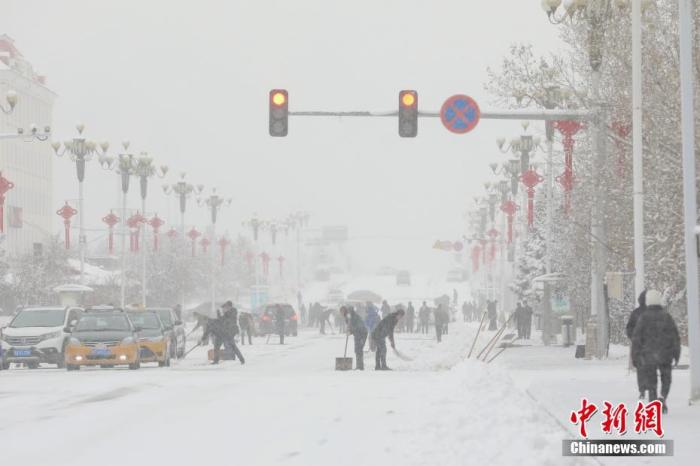Chinanews, November 4th. Will there be a large area of rain and snow this winter?
In response to this, Jia Xiaolong, deputy director of the National Climate Center, responded on the 4th that by around January next year, the cold air forces affecting China will be significantly stronger. The temperature in central and eastern China and most areas will be lower than usual, and the northern regions may Take precautions when there is strong ice and snow.
Data map: Citizens are clearing ice and snow roads.
Photo by Wang Jingyang issued by China News Service
The China Meteorological Administration held a November press conference on the 4th to introduce major weather and climate events in October and forecasts of climate trends in November.
At the meeting, a reporter asked whether there will be large areas of rain and snow this winter?
Compared with previous years, are there any changes in the amount and scope of rain and snow precipitation?
Will it affect the Spring Festival transportation?
Jia Xiaolong said that regarding the overall climate trend in China this winter, the relevant business research institutes and experts from domestic universities engaged in climate and climate research have recently been organized to discuss the climate trends this winter.
According to the current consultation opinion, the cold air affecting China is relatively frequent this winter, and the cold air force is generally stronger.
In addition, the cold air path affecting China this winter is mainly the northwest path.
Under such an overall situation, this winter, except for the warmer temperatures in the northeast, east coast and plateau areas, the temperature in most other areas is normal to low.
The precipitation is generally more in the north and less in the south. Because of the influence of La Niña, the water vapor transport conditions in the south are generally deviated and precipitation is less.
Jia Xiaolong said that China's climate change this winter is very obvious in stages, especially temperature changes.
In the early part of the winter, except for the low temperatures in western Inner Mongolia, Northwest China and South China, the temperature in most parts of the country was still normal to high.
Around January next year, the cold air forces affecting China will be significantly stronger. The temperature in the central and eastern regions and most areas will be lower than usual. There may be relatively strong ice and snow weather in the northern region. Take precautions.
Affected by La Nina in the south, the possibility of large-scale, continuous low-temperature rain and snow freezing this winter is relatively small.
However, in the east of Southwest China and the west of Jiangnan, there will still be periodic rain and snow in winter.
Jia Xiaolong pointed out that climate prediction itself is very difficult, and it is also a worldwide problem.
The changing factors and factors that affect climate are complex, from tropical regions to high-latitude polar regions. The interaction of these factors makes climate prediction difficult and uncertain.
“On the one hand, we are strengthening our understanding of climate mechanisms and laws, and at the same time developing some climate prediction methods. We will also monitor and consult in a timely manner in the later period to provide rolling climate trend prediction opinions.” Jia Xiaolong said.
In addition, a reporter asked a question that recently there was a video on the Internet showing that a large group of clouds appeared on one side of the Qinling Mountains, and the other side was clear.
The video attached to the video says that "Qinling blocked the air going south with its own strength". I would like to ask what the meteorological department thinks about this?
Jia Xiaolong responded that the distribution of global ocean continents, including landforms and mountain patterns, play an important role in the formation of climate.
For example, the Qinghai-Tibet Plateau plays a very important role in the formation of the monsoon climate in East Asia.
From the perspective of the Qinling Mountains, its scale is much smaller than that of the Qinghai-Tibet Plateau. The barrier height of the Qinling Mountains is about 3000 meters, and the Qinling Broad Mountain Range can reach thousands of kilometers.
Its uplift has a certain blocking effect on the airflow, on the one hand it has a blocking effect on the cold air coming down from the north, and on the other hand it also has a blocking effect on the transportation of water vapor to the north in the southern tropics.
Even small-scale mountains have an impact on the local weather and climate. Within its scale, it can have a certain impact on airflow, but it may not be able to stop the cold air that exceeds the scale.

